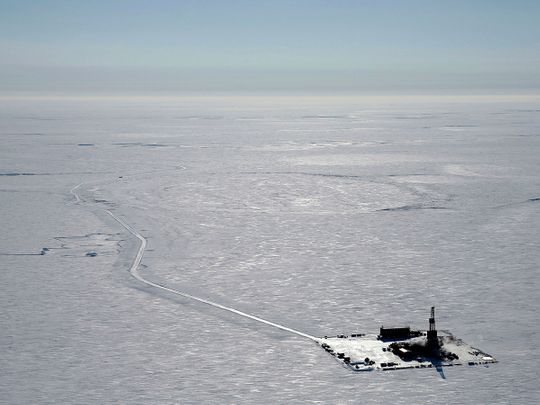
The world has its eyes on the Biden administration’s decision on the Willow Project on the Alaskan North Slope, as this vast new oilfield is estimated to hold 600 million barrels of oil.
This $8 billion drilling project can generate up to $17 billion in revenue. If the project takes shape as planned with five drilling sites, it will produce 180,000 barrels of oil daily, about 1.5 per cent of total oil production in the US.
Besides drilling sites, the project will also need a processing facility, nearly 100 kilometres of new roads, seven bridges, and an airstrip, creating 2,000 construction jobs and 300 permanent employees.
To put it in perspective, this massive Willow Project can provide much more crude oil than the present 372 million barrels of total Strategic Petroleum Research the US now has.
While the war in Ukraine has created uncertainties over global oil supply, and Biden has not only asked his allies to boost oil production but also was forced to decide the largest release of the country’s oil reserves, why is then he hesitant over deciding on a potentially game-changing oil-drilling project within the US territory?
Twenty-four years ago, the Clinton Administration signed the lease on Alaska’s North Slope, but oil was discovered only six years ago. Trump Administration, as expected, promptly approved the project.
But, before Biden Administration made up its mind, the District Court of Alaska on August 18, 2021 made a judgement that the environmental costs were not adequately considered by ConocoPhillips while planning the Willow Project.
Undoubtedly, the Willow Project will boost America’s domestic oil and gas production; it is financially lucrative and likely to create many jobs. However, it will also emit 278 million tons of greenhouse gases over the project’s thirty years of life.
This emission is equivalent to the total emission from 2 million cars over the same time period or 76 coal plants running for a year.
Besides noise, traffic, and pollution in a highly eco-sensitive zone, the project can also threaten the reindeer population — a vital source of livelihood for the native population. The project is also feared to endanger local wildlife like polar bears.
The severe ecological and environmental concerns of the Willow Project have put the Biden administration in a serious dilemma. Biden needs lower energy prices and more jobs for his reelection in 2024.
The ‘Climate President’
At the same time, Biden was elected to the White House, promising his supporters to be the ‘Climate President’. He pledged to end the country’s net carbon emission by 2050, and during his campaigns in September 2019, he even promised to end fossil fuel.
After being elected, he revoked a key permit and forced the cancellation of the high-profile Keystone XL pipeline that was expected to carry 830,000 barrels of oil sands per day from Alberta in Canada to Nebraska in the US but was being opposed by Native American tribes and environmentalists.
He has also cancelled the lease of million acres of land that was given to oil and gas companies for possible drilling. Only four months ago, he even accused oil companies of “war profiteering” and threatened to impose a windfall tax.
If Biden gives permission to Willow Project, that will be a huge setback to his climate policy record and will also upset one of his core support bases, primarily youths, and activists. The environmental campaigners are already unhappy over the Biden administration dropping its resistance to oil and gas leases in a compromise to pass the climate law in 2022.
The Biden administration is under severe pressure from local politicians, labour unions, and a large group of Alaska Natives demanding that the President approve the Willow Project.
The demand is Biden should listen to the people of Alaska. There is widespread political support and a ’majority consensus’ in support of the project in the state.
The 'democratic dilemma'
While campaigning, Biden had promised to end fossil fuel and become the Climate President, and he had also vowed to listen to local communities. The local communities of Alaska are overwhelmingly in favour of the massive oil and gas project as they hope it will bring economic and infrastructure development to the region.
Campaigning for election is one thing, but the art of governing is another altogether. Like in any other democracy, the American President realises the ‘democratic dilemma’ while deciding on the Willow Project. Biden can score big to boost his image as Climate President by blocking Willow.
Still, at the same time, he also understands the political and economic realities of oil demand in the country and the general perception of how to reduce it. Thus, he has been trying to find a middle ground for some time.

After months of delays, the US Bureau of Land Management brought out the supplemental environmental impact statement for the project last month. It has given its preferred alternative of approving three out of five proposed drilling sites.
At the same time, the US Interior Department released a statement expressing ‘substantial concern’ about the project and the Bureau of Land Management’s preferred alternatives.
The project has already been delayed for several years. Whatever decision the Biden Administration takes about the Willow Project, it could face lawsuits from multiple sides that could further delay the project.
The most important takeaway from the decision-making process over the Willow Project is that democracy, even if it is the US, is inherently hesitant to undertake the long-term problem-solving approach that climate change demands.
It will try to find a compromise, and these short-term escape routes will not be enough to confront the survival crisis that climate threats pose to the planet.









